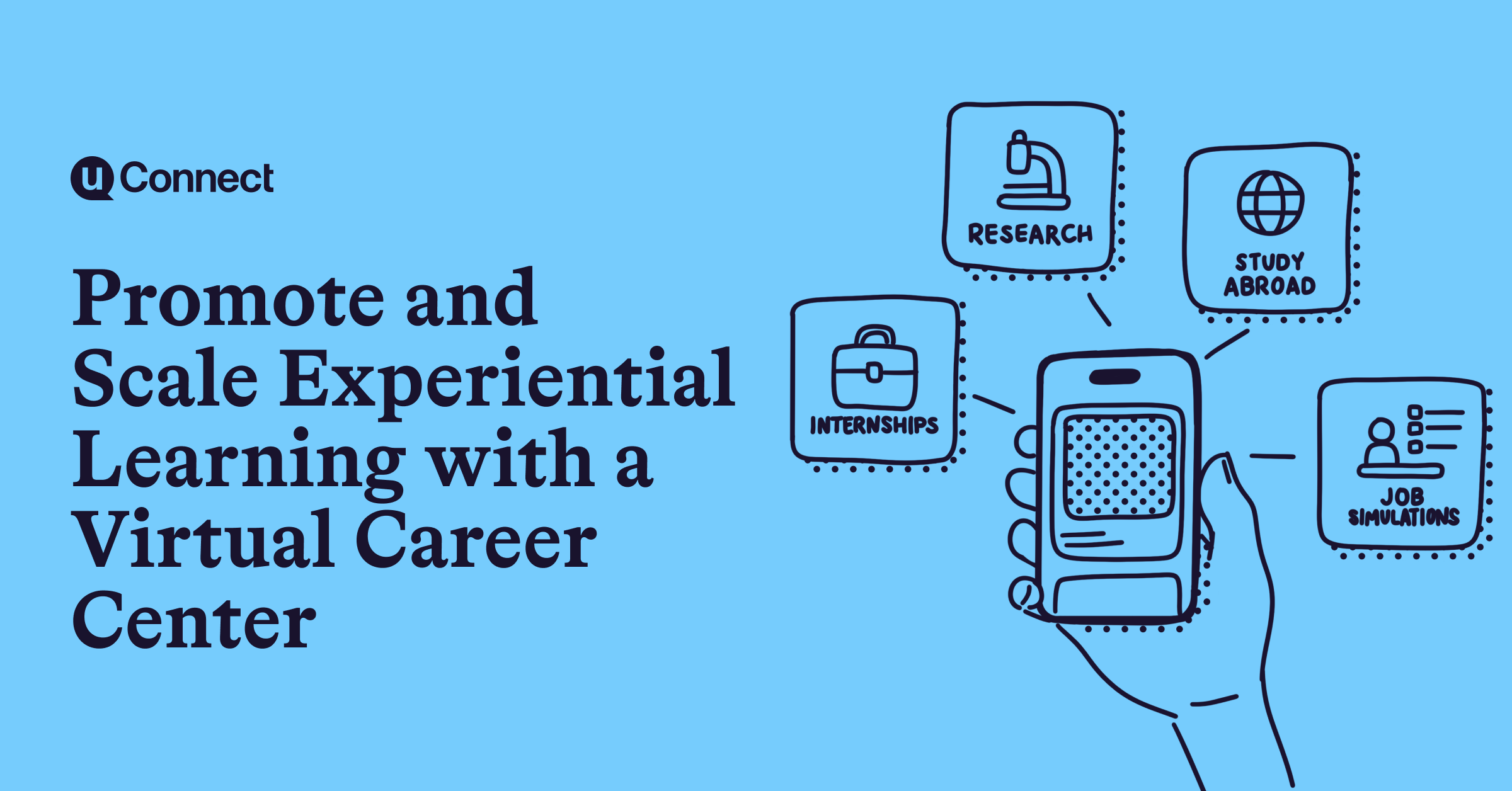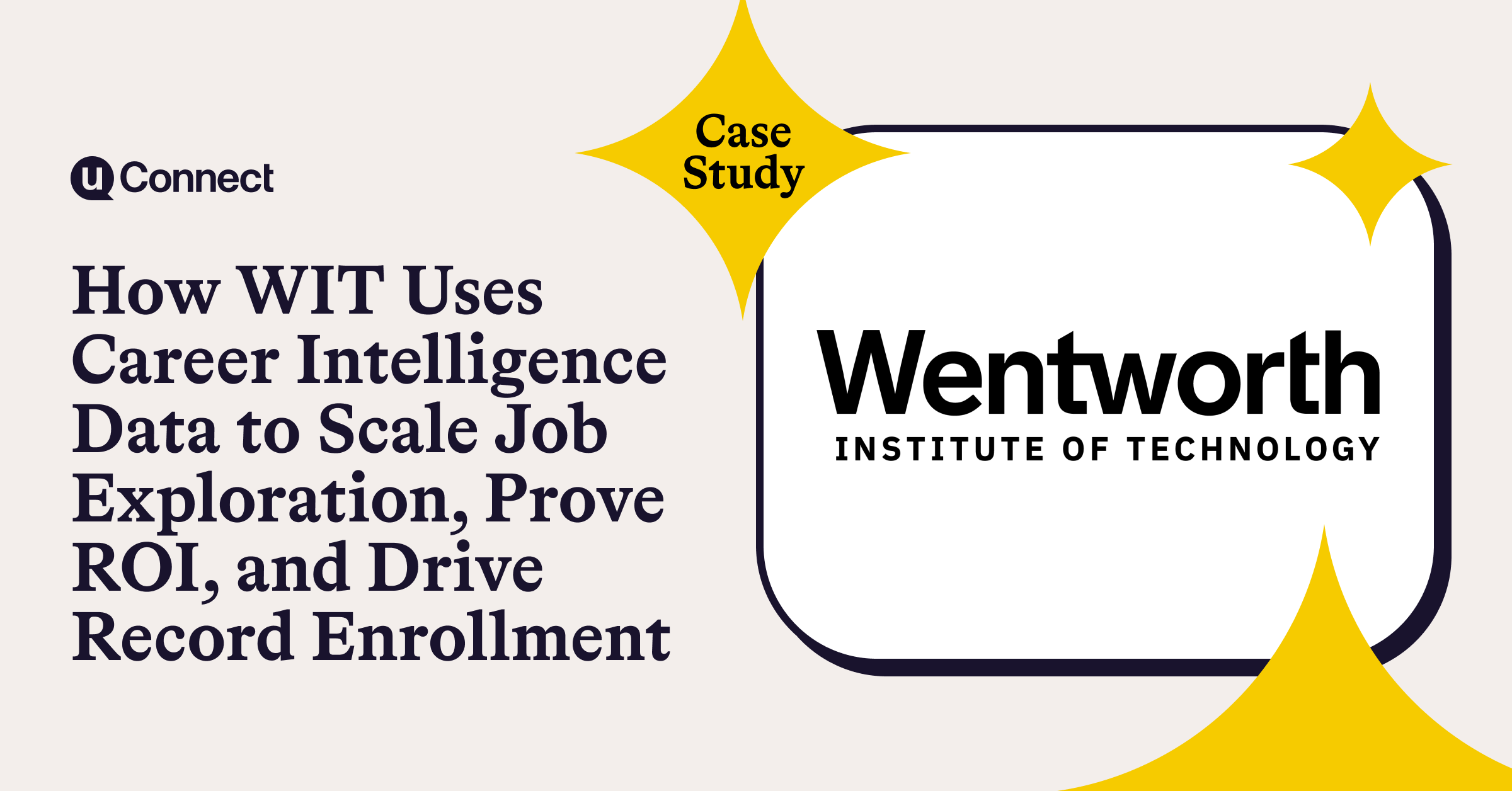Key challenges and focus areas:
1. Scattered and siloed experiential learning opportunities across campus
2. Low visibility and inconsistent promotion of hands-on learning programs
3. Limited student understanding of the term “experiential learning”
4. Need to align experiential learning with strategic institutional priorities like enrollment and retention
Experiential learning is having a moment, and for good reason.
Internships, research, study abroad, job simulations, service-learning: these are the experiences that help students connect classroom learning with the real world. They’re also some of the most impactful ways to build confidence, career clarity, and job market readiness.
But as institutions double down on experiential learning, one challenge becomes clear:
How do you create a single, student-friendly hub for experiential learning when opportunities live everywhere and nowhere all at once?
The hidden challenge: Visibility and access
The biggest barrier to experiential learning isn’t a lack of opportunities, but a lack of visibility.
Most campuses offer dozens (if not hundreds) of experiential programs, but they’re scattered across departments, hidden in PDFs, or promoted inconsistently. Students often hear about them through word-of-mouth, if they hear about them at all.
This decentralization:
- Stifles engagement
- Increases equity gaps
- Makes collaboration harder
- Limits data collection and storytelling
Why it matters: From outcomes to retention
Experiential learning is more than a buzzword; it’s a strategic lever for improving student success and institutional performance.
Students who participate in internships, job simulations, research, and other high-impact practices are more likely to stay enrolled, graduate on time, and land strong post-graduate outcomes. These outcomes, in turn, affect everything from institutional reputation to enrollment, retention, and revenue.
But if students can’t find these opportunities, none of that is possible. That’s why visibility, access, and promotion matter.
The solution: Centralized access through a Virtual Career Center
uConnect’s Virtual Career Center (VCC) brings all your career resources into one branded, easy-to-navigate hub. Students receive personalized recommendations based on their interests and can access jobs, events, internships, and more anytime, from any device.
But when it comes to scaling and managing experiential learning specifically, that’s where the Experiences Module comes in.
The Experiences Module is a component of the VCC that allows you to organize, promote, and track hands-on learning opportunities like internships, study abroad, job simulations, and more—all with less manual work.
With the Experiences Module, you can:
- Centralize experiential opportunities, whether they come from different departments, faculty, or external platforms like Forage and Parker Dewey
- Tag and curate experiences by major, identity, interest area, class year, and more
- Share opportunities throughout your VCC, including homepage feeds, industry pages, and newsletters
- Track student engagement with detailed data and reporting
- Automatically pull in Forage experiences without manual uploading
It’s the easiest way to simplify the student experience, scale your reach, and ensure every student can find hands-on opportunities that align with their goals.
Promote like a marketer, not a middleman
Most students aren’t checking several different resources to find an internship. They expect curated, personalized recommendations—just like they get on Spotify or Netflix.
The VCC helps you expand your reach by highlighting opportunities through homepage spotlights, personalized newsletters, and embedding experiences directly within major, identity, and interest-based community pages.
Imagine a student logging in and seeing a job simulation tagged to their major, a guide to applying for research assistantships, and a success story from another student. That’s the kind of visibility that drives action.
See it in action: UMass Amherst increased Forage engagement by 242%
At the Isenberg School of Management at UMass Amherst, the career team wanted to make experiential learning more accessible, especially for first-year and international students.
They used the Experiences Module to embed Forage virtual job simulations directly into their Virtual Career Center—curated by major, identity, and career interest.
Since implementation:
- Student engagement with Forage simulations increased by 242%
- Over 3,000 students clicked from the VCC into Forage in one academic year
- Most popular simulations included Electronic Arts’ Product Management, White & Case’s U.S. Debt Finance, and Red Bull’s Off-Premise Sales
What drove the results? The Isenberg team took a strategic, student-centered approach. They made Forage participation a requirement of a first-year career development course, ensured career coaches promoted simulations during advising sessions, and embedded curated experiences directly into their Virtual Career Center through the Experiences Module.
By removing friction, they turned passive content into active engagement. The takeaway: when experiential opportunities are centralized, curated, and marketed effectively, students respond.
Reframing the message: Swarthmore’s “Gain Experience” strategy
At Swarthmore College, experiential learning is a strategic priority. Following the launch of a new institutional plan focused on “educating the whole student,” the career services team was tasked with surfacing and promoting opportunities that connected learning within and beyond the classroom.
To meet that goal, Claire Klieger, Assistant Vice President and Executive Director of Career Services, and her team turned to their Virtual Career Center and Experiences Module to build a scalable, student-centered approach to experiential learning.
Klieger knew that simply listing opportunities wasn’t enough. Her team needed to package them in a way that matched how students think and search.
“It was less, ‘we need to build an experiential learning page’ and more, ‘what do we call these things to drive traffic?’” Klieger said. “It’s about surfacing resources that already exist and packaging them in a way that resonates.”
After conducting UX testing with the campus library’s user experience interns, the Swarthmore team found that students didn’t respond to the term “experiential learning” at all.
“Students don’t know what experiential learning means. It’s a term faculty and staff use—not students.”
So they shifted their strategy. Using the Experiences Module, they tagged and embedded individual Forage opportunities directly into their Virtual Career Center. Then, instead of highlighting them under a generic “experiential learning” label, they added clear, student-friendly calls to action like “Gain Experience” and “Build Skills” across their industry and identity-based community pages—places students already visit.
The results
This small change in language and placement led to a big shift in engagement:
- Individual Forage experiences received significantly more clicks and views
- The Intro to Data Science simulation quadrupled in views from 2023 to 2024
- The dedicated “Experiential Learning” page, by contrast, received only three visits total
“Students are landing on our industry pages, clicking on ‘Gain Experience,’ and exploring from there. They’re not looking for something called ‘experiential learning.’ They’re looking for something they can try.”
Swarthmore is now exploring how to use the Experiences Module to tag opportunities by career readiness competencies like communication and problem-solving, with the goal of better aligning their experiential offerings with both student language and institutional priorities.
Expand your reach and reduce your workload
The Experiences Module does more than help students. It empowers your whole campus to contribute to career readiness in meaningful and scalable ways.
- Faculty can link to curated experiences in syllabi or advising guides
- Staff can add opportunities without touching code or needing design skills
- Leadership can see engagement metrics to support strategic goals
- Career services teams can focus on strategy, not spreadsheets
The result is a more collaborative, data-informed, and student-centered approach to experiential learning that improves outcomes, strengthens retention, and supports institutional strategy.
Ready to make experiential learning more visible, accessible, and impactful?
Fill out the form below to see how a Virtual Career Center and the Experiences Module can support your goals.


